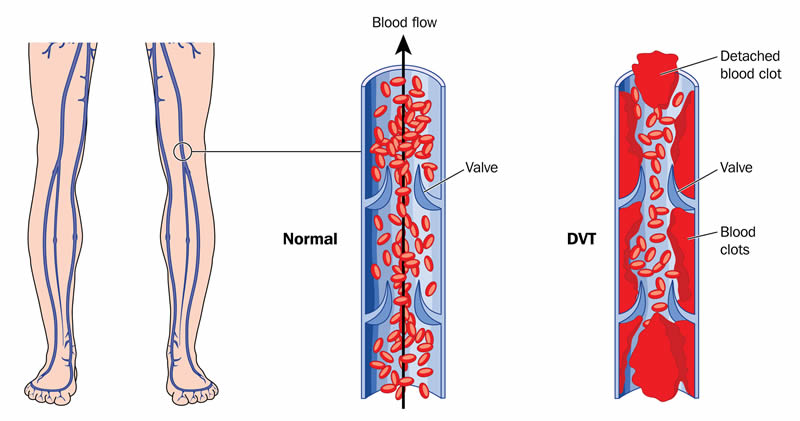The deep veins of the extremities are the veins within the muscles. Deep Venous Thrombosis (DVT), clotting in the deep veins is a serious condition which can lead to major disability or death if the thrombus migrates to the lungs and obstructs flow (pulmonary embolism).
A small thrombus (clot) in a small vein of the calf may be treated with close observation, oral aspirin therapy, elastic compression hose, and frequent walking or exercise in carefully selected cases with close ultrasound observation to be sure the thrombus is not propagating into larger veins. Other patients at higher risk for more extensive thrombus will be started on injectable and oral anticoagulant drugs immediately upon the diagnosis of DVT to prevent propagation of thrombus into the larger deep veins.

Thrombus in the larger deep veins such as the femoral veins of the thigh or the iliac veins of the pelvis usually will be treated with immediate anticoagulation with injectable anticoagulants, elastic support hose, and walking. Patients who have extensive new thrombus in the veins of the upper thigh or the pelvic/abdominal veins should be evaluated and considered for early clot removal. Currently, the best techniques for extensive early clot removal involve infusion of drugs into the thrombus through a small catheter which will dissolve the thrombus, often with the assistance of mechanical devices such as a rotating catheter or ultrasound waves directed into the clot. These pharmacomechanical techniques in carefully selected patients usually reduce the pain and swelling associated with extensive DVT, but they also considerably reduce the disability caused by post thrombotic syndrome (PTS) or development of venous ulceration months or years later.
Extensive DVT which is not treated with thrombolysis and which results in significant residual obstruction of deep veins in the thigh or pelvic (iliac) veins often causes PTS with chronic pain, swelling, tenderness, and venous stasis skin changes or ulcers at the ankle.
The most feared complication of DVT is pulmonary embolism (PE), migration of a clot to the veins of the lungs. PE can be lethal due to obstruction of blood flow through the lungs, but multiple episodes of small pulmonary embolisms may lead to gradual obstruction of the veins of the lungs leading to progressive shortness of breath and heart failure.
Some patients with DVT may require anticoagulant medications for a few months. Others require prolonged anticoagulation or lifelong anticoagulation. Because of the serious nature of DVT, it is important that if you develop acute swelling of an extremity to contact your doctor or a vein center immediately.
